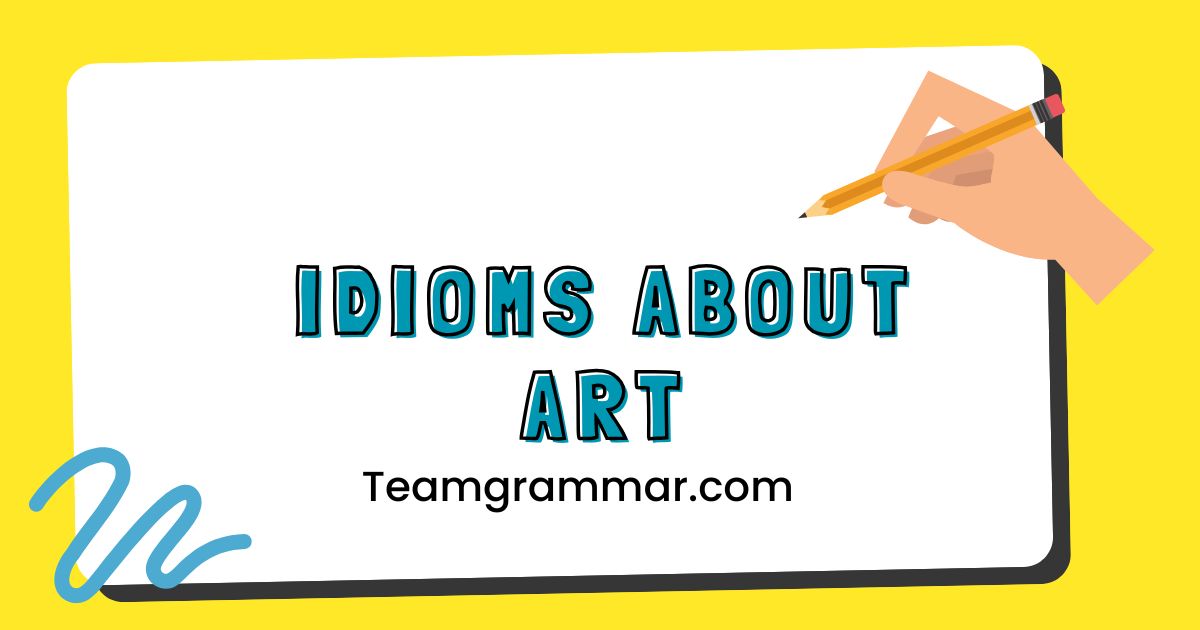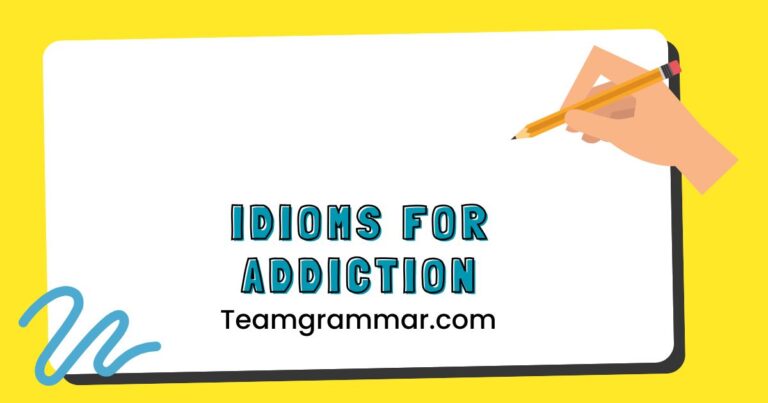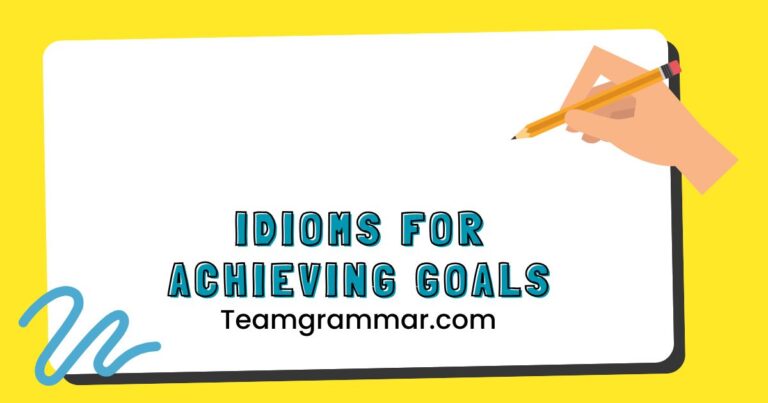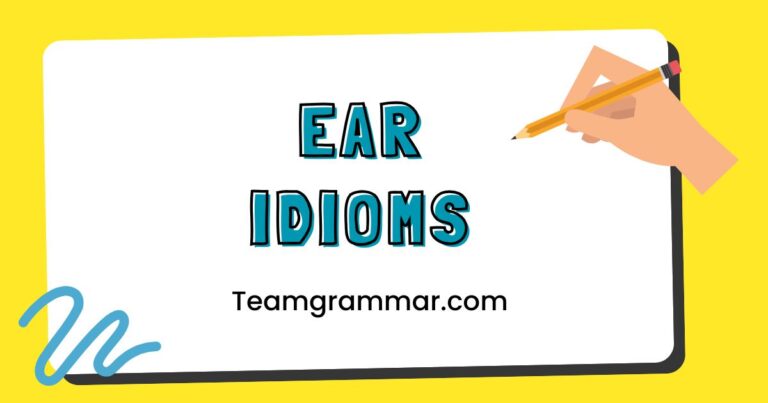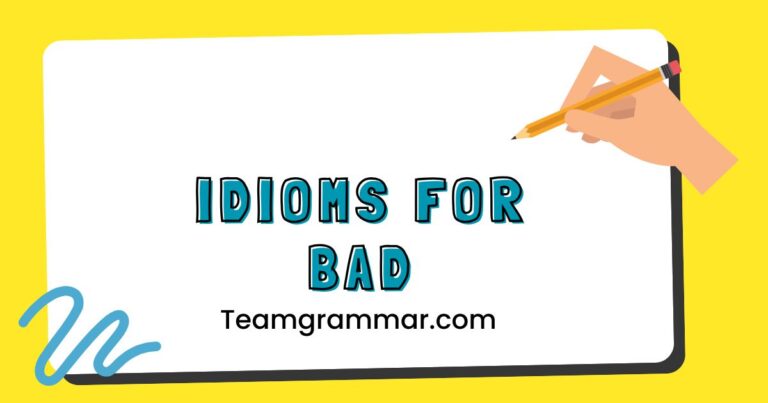35 Artful English: Mastering Idioms About Art and Creativity
Idioms are an integral part of the English language, adding color and depth to our conversations and writing. Understanding idioms, especially those related to art, enriches your comprehension and expressive abilities.
This article explores a variety of idioms connected to art, covering their meanings, usage, and providing numerous examples. Whether you’re an English language learner, a writer seeking to enhance your prose, or simply someone fascinated by the nuances of language, this guide will help you master art-related idioms.
Table of Contents
- Introduction
- Definition of Idioms About Art
- Structural Breakdown of Art Idioms
- Types and Categories of Art Idioms
- Examples of Art Idioms
- Usage Rules for Art Idioms
- Common Mistakes with Art Idioms
- Practice Exercises
- Advanced Topics in Art Idioms
- Frequently Asked Questions
- Conclusion
Introduction
Idiomatic expressions are phrases whose meanings cannot be understood from the literal definitions of the individual words. They offer a unique window into a culture’s way of thinking and expressing ideas.
Art-related idioms specifically draw upon the vocabulary and concepts of art to convey broader, often metaphorical, meanings. Mastering these idioms will not only improve your English proficiency but also provide a deeper appreciation for the creative process and its influence on language.
This article aims to dissect and explain various idioms related to art, offering clear definitions, examples, and practical usage tips. By understanding the nuances of these expressions, you can communicate more effectively and add a touch of artistry to your own language.
Whether you are preparing for an English exam, writing creatively, or simply looking to expand your vocabulary, this comprehensive guide will serve as a valuable resource.
Definition of Idioms About Art
An idiom is a phrase or expression whose meaning cannot be understood from the ordinary meanings of the words it contains. Idioms are figurative language, relying on metaphor, simile, or other literary devices to create a non-literal meaning.
Art idioms are a subset of idioms that use art-related terms and concepts to convey abstract ideas or emotions. These idioms often draw upon the visual arts, such as painting, drawing, sculpture, and performance art, to create vivid and memorable expressions.
Art idioms function like any other idiom, serving to add color and nuance to language. They allow speakers and writers to express complex ideas in a concise and evocative way.
The context in which an art idiom is used is crucial for understanding its intended meaning. Without understanding the implied meaning, the phrase can sound nonsensical or confusing.
Classification of Art Idioms
Art idioms can be classified based on the type of art they reference or the concept they convey. Some idioms relate to color, such as “paint the town red,” while others relate to the process of creating art, such as “sketchy” or “a blank canvas.” Some might be related to the art market, reflecting the business side of art.
This classification helps understand the origin and usage of these idioms.
Function of Art Idioms
The primary function of art idioms is to add depth and color to the language. They enable speakers and writers to express emotions, describe situations, or convey ideas in a more vivid and engaging manner.
Art idioms also serve to connect the speaker with the audience, as understanding and using idioms correctly demonstrates a certain level of cultural and linguistic competence.
Contexts for Using Art Idioms
Art idioms can be used in a wide range of contexts, from casual conversations to formal writing. However, it’s important to consider the audience and the purpose of the communication.
In formal settings, it’s best to use idioms sparingly and choose those that are widely understood. In informal settings, you can be more liberal with your use of idioms, as they can add a personal touch to your communication.
Understanding the specific nuance of an idiom is important before using it, as misusing it can lead to confusion or misinterpretation.
Structural Breakdown of Art Idioms
Art idioms, like other idioms, often consist of a fixed structure that cannot be altered without changing the meaning or making the phrase nonsensical. The structure typically includes a combination of nouns, verbs, adjectives, and prepositions, arranged in a specific order.
Understanding the structural elements of art idioms can help you recognize and use them correctly.
For example, the idiom “paint oneself into a corner” has a specific structure: verb (paint) + reflexive pronoun (oneself) + preposition (into) + noun (corner). Changing the order or the words would destroy the idiomatic meaning.
Recognizing these patterns allows for better recall and application of the idioms within appropriate situations.
Common Patterns in Art Idioms
Several common patterns appear in art idioms. One pattern involves using color terms to describe emotions or situations, such as “feeling blue” or “seeing red.” Another pattern involves using the act of creating art to describe problem-solving or decision-making, such as “drawing a line in the sand” or “painting a picture” of a scenario.
Recognizing these patterns can assist in understanding the underlying meaning.
Grammatical Rules and Art Idioms
While idioms are not always grammatically straightforward, they still adhere to certain grammatical rules. The tense of the verb in an idiom, for example, can change to reflect the time frame of the situation being described.
For example, “paint the town red” can be changed to “painted the town red” to indicate that the action happened in the past. However, the core structure of the idiom remains the same.
Types and Categories of Art Idioms
Art idioms can be categorized based on the aspect of art they reference. These categories help in understanding the different ways art informs language.
General Art Idioms
These idioms use general art terms to convey broader meanings, such as “a blank canvas” (a new opportunity) or “masterpiece” (an outstanding achievement).
Color Related Art Idioms
These idioms use color terms to describe emotions, situations, or characteristics, such as “feeling blue” (sad) or “green with envy” (jealous).
Drawing and Painting Idioms
These idioms use terms related to drawing and painting to describe problem-solving, decision-making, or portraying a situation, such as “drawing a line in the sand” (setting a limit) or “painting a picture” (describing a situation).
Sculpture Related Idioms
These idioms use terms related to sculpture to talk about shaping or molding something, such as “chiseling away” (gradually improving something).
Performance Art Idioms
These idioms use terms related to performance to describe actions such as acting, pretending, or being in the spotlight. Examples include “steal the show” (outshine others) and “waiting in the wings” (ready to take action).
Examples of Art Idioms
Understanding idioms requires seeing them in context. Here are several examples of art idioms, categorized for clarity.
General Art Idioms
The following table provides examples of general art idioms, their meanings, and example sentences.
| Idiom | Meaning | Example Sentence |
|---|---|---|
| A blank canvas | A fresh start or opportunity. | Starting a new job is like having a blank canvas; you can create anything you want. |
| Masterpiece | An outstanding work of art or achievement. | Her latest novel is a masterpiece of storytelling. |
| State of the art | The latest and most advanced technology or design. | The new hospital is equipped with state-of-the-art medical equipment. |
| Picture is worth a thousand words | A visual representation conveys a message more effectively than words. | The devastation caused by the hurricane was evident; a picture is worth a thousand words. |
| Paint a picture | To describe something in detail. | The witness painted a vivid picture of the crime scene for the jury. |
| Larger than life | Someone who is more exciting or impressive than ordinary people. | The actor was a larger-than-life personality, both on and off the screen. |
| Cut and paste | To copy and move something from one place to another. | I can just cut and paste this paragraph into the report. |
| Frame of reference | A set of ideas, conditions, or assumptions that determine how you will approach something. | His frame of reference is different because he grew up in another country. |
| In the picture | Involved in or aware of something. | I want to be kept in the picture about the project’s progress. |
| Out of the picture | No longer involved or relevant. | After the scandal, he was out of the picture. |
| Get the picture | Understand the situation. | I think I get the picture now; thanks for explaining. |
| A fine line | A subtle difference between two things. | There’s a fine line between confidence and arrogance. |
| The big picture | The overall perspective or context. | It’s important to focus on the big picture and not get bogged down in the details. |
| Gloss over | To avoid discussing something. | The politician glossed over the controversial issue in his speech. |
| Under the surface | Not immediately obvious. | There’s more to the story than what’s visible on the surface. |
| Draw the line | To set a limit. | I draw the line at lying; I will never do that. |
| A work in progress | Something that is still being developed or improved. | The new website is a work in progress, but it’s improving every day. |
| Copycat | Someone who imitates another person’s work or ideas. | He accused her of being a copycat because she used the same design. |
| True to life | Accurately representing reality. | The movie was praised for being true to life. |
| Go back to the drawing board | To start over from the beginning. | The project failed, so we have to go back to the drawing board. |
| In broad strokes | Describing something in general terms without details. | He outlined the plan in broad strokes, without going into specifics. |
| A touch of class | An element that adds elegance or sophistication. | Her stylish dress added a touch of class to the event. |
| Put the finishing touches | To add the final details to complete something. | She spent the morning putting the finishing touches on the presentation. |
| A stroke of genius | A brilliant idea or act. | Hiring her was a stroke of genius; she has transformed the company. |
Color Related Art Idioms
The following table illustrates idioms using color terms, their meanings, and example sentences to show their usage.
| Idiom | Meaning | Example Sentence |
|---|---|---|
| Feeling blue | Feeling sad or depressed. | She’s been feeling blue since her cat died. |
| Seeing red | Becoming very angry. | When he saw the damage to his car, he started seeing red. |
| Green with envy | Jealous. | She was green with envy when she saw his new car. |
| In the black | Profitable. | The company is finally in the black after a difficult year. |
| In the red | Operating at a loss. | The business has been in the red for the last three months. |
| White as a ghost | Extremely pale, usually from fear or shock. | She turned as white as a ghost when she heard the news. |
| Golden opportunity | A very good chance to do something. | This is a golden opportunity to invest in the company. |
| Gray area | A situation that is not clear or definite. | The rules are unclear, so it’s a bit of a gray area. |
| Black and white | Clear and easily understood. | The issue is not as black and white as it seems. |
| Once in a blue moon | Very rarely. | I only go to the cinema once in a blue moon. |
| Out of the blue | Unexpectedly. | He called me out of the blue after many years. |
| With flying colors | With great success. | She passed the exam with flying colors. |
| Show your true colors | Reveal your real personality or intentions. | He showed his true colors when he started lying to everyone. |
| Paint the town red | Go out and celebrate in a lively way. | Let’s paint the town red after the graduation ceremony. |
| Rose-colored glasses | A positive or optimistic view of things, often unrealistic. | She sees the world through rose-colored glasses. |
| Catch someone red-handed | Catch someone in the act of doing something wrong. | He was caught red-handed stealing from the store. |
| Red tape | Excessive bureaucracy or regulations. | We had to deal with a lot of red tape to get the permit. |
| A red herring | A distraction or misleading clue. | The detective realized the clue was a red herring. |
| Black sheep | A person who is different from the rest of their family or group. | He’s the black sheep of the family. |
| Give the green light | Give permission to proceed. | The boss gave the green light to start the project. |
| See through rose-colored glasses | Have an optimistic or idealistic view of something, often unrealistic. | She sees through rose-colored glasses and doesn’t recognize the problems. |
| Gray matter | Intelligence, brainpower. | This problem requires some serious gray matter to solve. |
| Silver lining | A positive aspect in a negative situation. | Even in this disaster, there’s a silver lining. |
| As good as gold | Well-behaved, obedient. | The children were as good as gold during the trip. |
Drawing and Painting Idioms
The following table lists drawing and painting idioms, their definitions, and example sentences to show how they are used.
| Idiom | Meaning | Example Sentence |
|---|---|---|
| Draw a line in the sand | To set a limit or boundary. | I’m drawing a line in the sand; I won’t tolerate that behavior anymore. |
| Paint oneself into a corner | To create a difficult situation for oneself. | By lying to the boss, he painted himself into a corner. |
| Paint a picture | To describe something in detail. | The author painted a vivid picture of the countryside in his novel. |
| Color outside the lines | To act or think differently or unconventionally. | She likes to color outside the lines and challenge traditional ideas. |
| Sketchy | Suspicious or unreliable. | That guy seems a bit sketchy; I don’t trust him. |
| Fill in the blanks | Provide missing information. | Can you fill in the blanks and tell me what happened last night? |
| In broad strokes | Describing something in general terms without details. | He outlined the plan in broad strokes, without going into specifics. |
| Erase the past | To forget or remove past mistakes or events. | He wished he could erase the past and start over. |
| Draw a blank | To fail to remember something. | I tried to remember his name, but I drew a blank. |
| Come to light | To become known or revealed. | The truth about the scandal finally came to light. |
| Brush up on | To review or improve one’s knowledge of something. | I need to brush up on my French before the trip. |
| Clear as mud | Not clear at all; confusing. | The instructions were as clear as mud. |
| In black and white | In writing; clear and definite. | I need to see it in black and white before I believe it. |
| Read between the lines | To understand the hidden meaning. | You have to read between the lines to understand what he really means. |
| Touch something up | To make small improvements or repairs. | I need to touch up the paint on the walls. |
| Draw someone out | To encourage someone to talk or express their feelings. | The therapist tried to draw her out during the session. |
Sculpture Related Idioms
The following table provides examples of sculpture-related idioms, along with their meanings and example sentences.
| Idiom | Meaning | Example Sentence |
|---|---|---|
| Chisel away | Gradually improve something by persistent effort. | He’s been chiseling away at his novel for years. |
| Set in stone | Fixed and unchangeable. | The company’s policies are not set in stone and can be revised. |
| Carve out a niche | Create a specific role or position for oneself. | She carved out a niche for herself in the industry. |
| Mold someone | To shape or influence someone’s character or behavior. | His parents tried to mold him into a doctor. |
| Smooth over | To resolve a problem or disagreement. | He tried to smooth over the argument with an apology. |
| Take shape | To begin to develop into a clear form. | The project is finally starting to take shape. |
| Rough around the edges | Not refined or polished. | The restaurant is rough around the edges, but the food is great. |
Performance Art Idioms
The following table provides examples of performance art related idioms, their meanings, and example sentences.
| Idiom | Meaning | Example Sentence |
|---|---|---|
| Steal the show | To receive more attention and praise than anyone else. | The young actress stole the show with her performance. |
| Waiting in the wings | Ready to take action or replace someone. | He’s been waiting in the wings for his chance to lead the company. |
| Take center stage | To become the focus of attention. | The issue of climate change has taken center stage in recent years. |
| All the world’s a stage | Life is a theatrical performance. | As Shakespeare said, all the world’s a stage. |
| Behind the scenes | In a private or non-public setting. | A lot of work goes on behind the scenes to make the event successful. |
| Curtain call | The final bow at the end of a performance. | The actors received a standing ovation and several curtain calls. |
| Drop a bombshell | Reveal shocking news. | He dropped a bombshell when he announced he was leaving the company. |
| A tough act to follow | A performance or achievement that is difficult to surpass. | His success will be a tough act to follow. |
Usage Rules for Art Idioms
Using art idioms correctly requires understanding their specific meanings and contexts. While idioms add color to the language, misuse can lead to confusion or miscommunication.
1. Context is Key:Always consider the context in which you are using the idiom.
Make sure the meaning of the idiom fits the situation you are describing.
2. Audience Awareness:Be mindful of your audience.
Some idioms may be unfamiliar to non-native speakers or to people from different cultural backgrounds.
3. Grammatical Structure: While idioms have fixed structures, verbs within them can be conjugated to fit the tense of the sentence.
4. Avoid Overuse:Using too many idioms can make your language sound unnatural or forced.
Use them sparingly to have the most impact.
Exceptions and Special Cases
Some art idioms have variations in their usage depending on regional dialects or specific contexts. For example, the phrase “paint the town” might have different connotations in different areas.
Always be aware of these potential variations and adjust your usage accordingly.
Common Mistakes with Art Idioms
One common mistake is interpreting idioms literally. For example, understanding “paint the town red” as actually painting a town red, rather than celebrating wildly.
Mistake 1: Literal Interpretation
- Incorrect: “He was feeling blue, so he literally painted his room blue.”
- Correct: “He was feeling blue, so he stayed home and listened to sad music.”
Mistake 2: Misusing the Idiom in the Wrong Context
- Incorrect: “The company is feeling blue because they made a huge profit.”
- Correct: “The company is in the black after a successful quarter.”
Mistake 3: Overusing Idioms
- Incorrect: “He painted himself into a corner, and then he saw red and went back to the drawing board, but it was clear as mud.”
- Correct: “He made a mistake and had to start over, but the instructions were confusing.”
Practice Exercises
Test your understanding of art idioms with the following exercises.
Exercise 1: Fill in the Blanks
Choose the correct idiom from the list to complete each sentence. (a blank canvas, masterpiece, state of the art, paint the town red, feeling blue)
| Question | Answer |
|---|---|
| 1. After winning the championship, the team decided to __________. | paint the town red |
| 2. The new museum is equipped with __________ technology. | state of the art |
| 3. Starting a new project is like having __________. | a blank canvas |
| 4. She’s been __________ since her vacation ended. | feeling blue |
| 5. The artist’s latest work is considered a __________. | masterpiece |
Exercise 2: Multiple Choice
Choose the correct meaning of the idiom in each sentence.
| Question | Options | Answer |
|---|---|---|
| 1. He drew a line in the sand when he refused to work overtime. | a) Started a drawing b) Set a limit c) Made a mistake | b) Set a limit |
| 2. The truth finally came to light after the investigation. | a) Became known b) Disappeared c) Stayed hidden | a) Became known |
| 3. She was green with envy when she saw her friend’s new car. | a) Feeling sick b) Feeling jealous c) Feeling happy | b) Feeling jealous |
| 4. The politician glossed over the controversial issue. | a) Addressed directly b) Ignored c) Emphasized | b) Ignored |
| 5. The project is starting to take shape after months of planning. | a) Fall apart b) Become clear c) Become confusing | b) Become clear |
Exercise 3: Sentence Completion
Complete the following sentences using an appropriate art idiom.
| Question | Answer |
|---|---|
| 1. After the failure, they had to __________. | go back to the drawing board |
| 2. He was caught __________ stealing the documents. | red-handed |
| 3. The company is __________ after a successful year. | in the black |
| 4. She __________ at the audition. | stole the show |
| 5. The rules about this are a __________. | gray area |
Advanced Topics in Art Idioms
For advanced learners, exploring the etymology and cultural context of art idioms can provide a deeper understanding of their meaning and usage. Researching the origins of idioms like “paint the town red” or “a blank canvas” can reveal fascinating insights into the history of language and culture.
Additionally, exploring the use of art idioms in literature and other forms of media can enhance your appreciation for their expressive power. Analyzing how authors and filmmakers use these idioms to create vivid imagery and convey complex ideas can improve your own writing and communication skills.
Studying regional variations in the use of art idioms can also be a rewarding challenge. Some idioms may be more common in certain parts of the world than others, and their meanings may vary slightly depending on the cultural context.
By expanding your knowledge of these variations, you can become a more fluent and culturally sensitive communicator.
Frequently Asked Questions
Here are some frequently asked questions about art idioms.
- What is an idiom?
An idiom is a phrase or expression whose meaning cannot be understood from the ordinary meanings of the words it contains. It’s a figurative expression that conveys a specific idea or emotion.
- What are art idioms?
Art idioms are a subset of idioms that use art-related terms and concepts to convey abstract ideas or emotions. They draw upon the visual arts, such as painting, drawing, and sculpture, to create vivid and memorable expressions.
- Why is it important to learn art idioms?
Learning art idioms enhances your understanding of the English language, improves your ability to express complex ideas, and adds color and nuance to your communication. It also provides a deeper appreciation for the creative process and its influence on language.
- How can I improve my understanding of art idioms?
You can improve your understanding of art idioms by studying examples, practicing their usage in different contexts, and researching their origins and cultural significance.
- Are art idioms used in formal writing?
Art idioms can be used in formal writing, but it’s important to use them sparingly and choose those that are widely understood. Avoid using idioms that are too colloquial or informal.
- Can I change the words in an art idiom?
No, idioms have fixed structures, and changing the words can alter the meaning or make the phrase nonsensical. However, the tense of the verb in an idiom can be changed to fit the time frame of the situation being described.
- What is the difference between a metaphor and an idiom?
A metaphor is a figure of speech that directly compares two unrelated things, while an idiom is a phrase whose meaning is different from the literal meanings of its individual words. Idioms often contain metaphors, but not all metaphors are idioms.
- How can I find more examples of art idioms?
You can find more examples of art idioms in books, articles, movies, and online resources. Look for phrases that use art-related terms in a figurative way.
- Are there any regional variations in the use of art idioms?
Yes, some art idioms may be more common in certain parts of the world than others, and their meanings may vary slightly depending on the cultural context. Be aware of these potential variations and adjust your usage accordingly.
- How do I know if I’m using an art idiom correctly?
You can check if you’re using an art idiom correctly by consulting a dictionary or online resource. Pay attention to the context in which the idiom is used and make sure the meaning fits the situation you are describing.
- What are some resources to learn more about idioms?
Dictionaries, online idiom guides, and language learning websites are great resources. Regularly reading English literature and watching English-language media can also help you pick up idioms naturally.
- How can I practice using idioms in my daily conversations?
Try to incorporate one or two new idioms into your conversations each day. Pay attention to how native speakers use idioms and mimic their usage. Don’t be afraid to ask for clarification if you’re unsure of the meaning of an idiom.
Conclusion
Mastering art idioms is a valuable skill for anyone looking to enhance their English proficiency and communicate more effectively. By understanding the meanings, usage rules, and common mistakes associated with these expressions, you can add color and nuance to your language and express complex ideas in a more vivid and engaging manner.
Remember to consider the context, be aware of your audience, and avoid overusing idioms.
Continue to explore new idioms, practice their usage, and research their origins and cultural significance. With dedication and practice, you can become a master of artful English and unlock the full potential of this expressive language.
Keep practicing, and you will find yourself using these idioms naturally and confidently.

